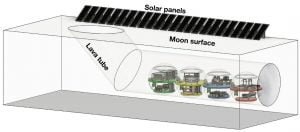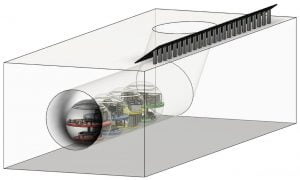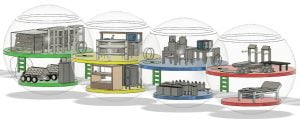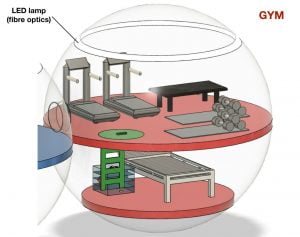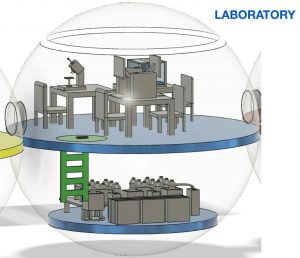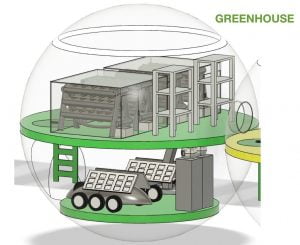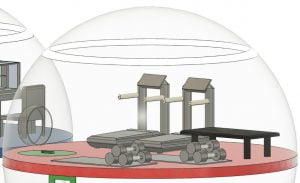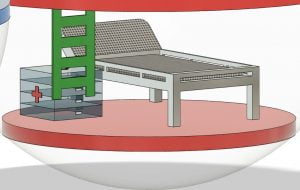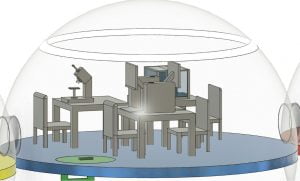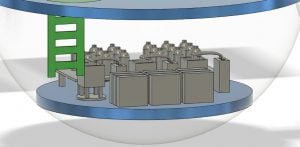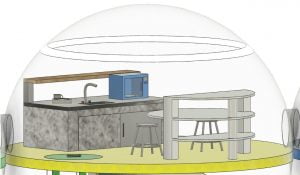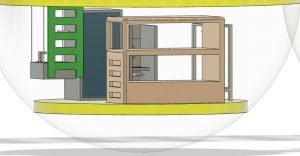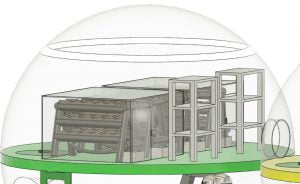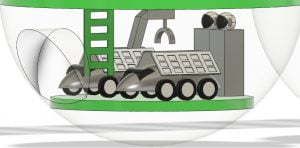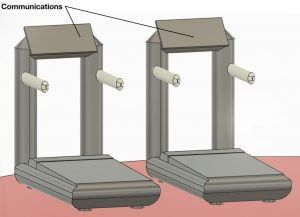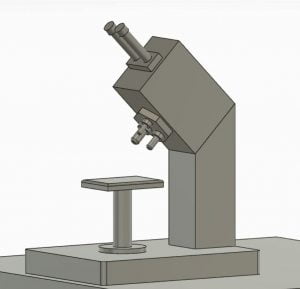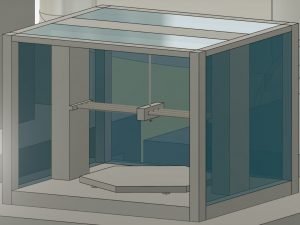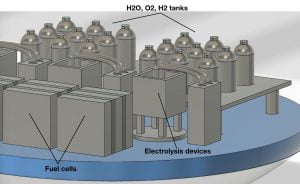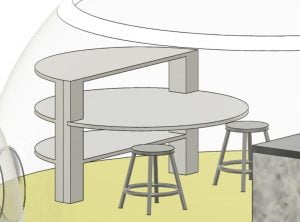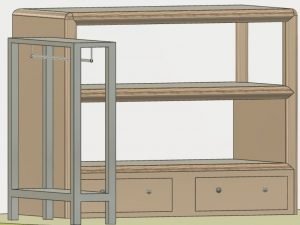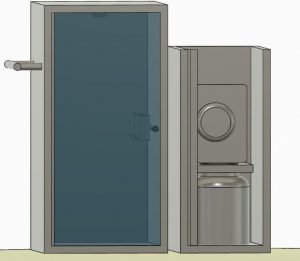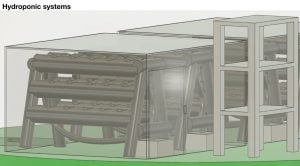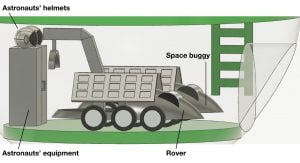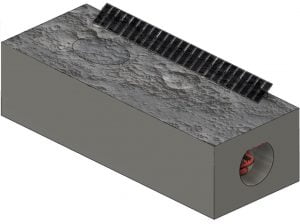|
Project description
The *PHILOL-HOUSE* project features advanced technologies that will help astronauts create the best environment to live in and conduct high-level scientific researches.
Our team will be involved in the study of the lunar environment, as well as in a deep analysis of soil composition and light incidence. Moreover, our mission will be focused on researches concerning water availability, water supplies and environmental temperatures. In addition to this, we will study the development of what will become an actual lunar settlement designed to be inhabited indefinitely in the future.
The base will be located near the North Pole inside a lava tube in the Philolaus crater. This strategic position allows the astronauts to take advantage of the sunlight (with solar panels and fuel cells) and of abundant water supplies. Being underground, the base will also be able to protect our astronauts from many risks; among them the base offers a shelter against meteorites and radiations.
The settlement will be made up of four main structures, each of them divided in two spaces: an upper part corresponding to a living area and a lower one used as a storage.
The *PHILOL-HOUSE* project has been studied to host astronauts for a long period of time, creating a self-sufficient settlement which employs local resources (such as water, regolith and sunlight) and recycles them reducing the final waste
|
|
Where do you want to build your Moon Camp?
We decided to settle in a lunar crater called Philolaus, 550 km away from the North Pole (72°13′12″N 32°52′48″W), inside which there is a lava tube formation (15-30 metres).
The lava tube will protect the astronauts from the three main threats of the lunar environment: radiations, meteorites and temperature excursion. Since we have found shelter underground, meteorites and radiations would become a secondary problem. Settling underground also drastically reduces the outer temperature range: inside the lava tube, the medium temperature is around -4 F (-20 C).
The Philolaus crater is the best option due to its position: it is near the Pole which means a large amount of water is available as well as an exposure to the sunlight which is much longer here than in other places on the planet.
How do you plan to build your Moon Camp? Describe the techniques and materials you would use.
First of all, a rover and a space buggy, 3D printers and aluminum pieces will be sent to the moon by a rocket in order to start the construction of the camp and the forniture before the arrival of astronauts.
Our base is made up of four self-inflating structures that adapt to the morphology of the underground environment; moreover, each ‘room’ is horizontally divided by an aluminum plate: in the upper part there are the habitable areas, while in the lower space many tools (including a rover, devices for organic food recycling and a water purifier, containers for food, water, hydrogen and oxygen, medical accessories, fuel cells and electrolysis devices both for water and O2 regolith extraction) are collected.
A ramp is used to allow the rover to enter the interior of the crater while each living space has a passage to reach the part below the habitable rooms where the various tools are contained; moreover, each room is connected to the next one by a passage through the wall.
In our moon camp there are four living spaces: the first one is the greenhouse, which allows plants to take advantage of the light coming from outside the crater to power the hydroponic systems. Secondly, there is the astronauts’ home consisting of a bedroom, a bathroom, a kitchen and a living room. Thirdly, there is the laboratory used for scientific research and, finally, a gym; both in the gym and in the laboratory there will be communication centres with the Earth.
The environment on the Moon is very dangerous for the astronauts. Explain how your Moon Camp will protect them.
Our underground accommodation will allow astronauts to be constantly protected from radiation, but also from meteorites and heat changes. Should the astronauts leave the accommodation, they will be protected by a space suit which provides adequate protection for the time they are away from the base.
However, the environment on the Moon can also damage the astronaut’s body that will be able to stay healthy and constantly monitored thanks to the gym equipment. Finally, if mental problems arise, there are means of communication and psychological help provided by the Earth system control.
Explain how your Moon Camp will provide the astronauts with:
|
|
For the first few days on the Moon, astronauts will survive thanks to some water supplies carried from Earth. Then, water will be obtained from the lunar pole where water reserves are extremely abundant. Astronauts will use drones equipped with light and ranging detectors to monitor the surface geology and radar geoscanners to look for water underground and understand where to excavate. Water is mainly icy, that is the reason why it is necessary to use heated tools to extract it from the ground. Once extracted, water will be transported (in the form of ice) to our Moon base thanks to the rover; here, it will be purified from contaminants using specific purifiers.
|
The astronauts will eat freeze-dried food that they have brought from Earth for the first period of time. They will then begin to grow microgreens (which grow in just 15 days) such as tomatoes, broccoli and savoy cabbage; these vegetables will be grown in hydroponic greenhouse.
Astronauts will be able to grow some other vegetables such as spinach, watercress, rocket, radishes, rye, quinoa, chives, peas and leeks, in an indoor culture medium consisting of regolith and organic waste used as fertilizer.
An important supplement in the diet will be spirulina algae, brought from Earth, with high nutrient values which will fill the lack of vitamins B and C.
Our team will grow potatoes and sweet potatoes to satisfy carbohydrate needs. They will also eat some dried food sent from earth.
The protein consumed by the astronauts will be created by a 3D printer from animal protein filaments brought from Earth.
|
Energy is directly employed using fibre optics (opportunely filtered in entrance) which conduct light energy in the underground spaces and it is contemporary stored during the lunar day thanks to solar panels installed at the Pole near our base. During the lunar night the energy is supplied by the fuel cells that had previously stored it during the day (being connected to the solar panels). Fuel cells are also a solution in the case of lunar eclipses. This energy can be used for many purposes, for example to power LED lamps. Moreover, as far as the propellant and heating systems are concerned, hydrogen and methane will be our energy sources: we get hydrogen from the electrolysis of water (which also produces oxygen) while we get methane from the composting of organic waste; the inorganic waste (plastic and metals) is recycled through a 3D printer.
|
Oxygen is obtained in two main ways: first of all, it can be extracted from regolith; in this case it has to be purified after the extraction and then stored in specific containers. Even though regolith contains large quantities of oxygen, in order to satisfy important requests it can also be obtained from water electrolysis. Thanks to this simple process, water (previously purified) produces oxygen and hydrogen.
The oxygen we obtain from these processes can be used for astronauts’ survival, becoming breathable air in living spaces thanks to specific humidifiers.
|
|
Explain what would be the main purpose of your Moon Camp (for example: commercial, scientific, and/or tourist purposes).
The main purpose of our exploration is scientific: firstly, we think there is a need for further analysis of environmental lunar parameters (such as soil, air, water and light conditions) and for the development of advanced food production techniques. Secondly, settling on the moon would test and improve human adaptive capacities, which could be useful for further future settlements; finally, having a base on the moon would be extremely convenient as an intermediate step to even more distant locations, such as Mars which is the future aim of many Space Agencies.
|
|
Describe a day on the Moon for your Moon Camp astronaut crew.
The astronauts wake up after the regular 8-hour-sleep. Once awake they have breakfast. Then they spend an hour in the gym having their daily workout, previously planned by experts to preserve astronauts’ muscle mass.
After the workout, the management of the greenhouse is entrusted to one astronaut while the remaining part of the crew carries out research in the laboratory: the team will study gravity and its effects, such as mass loss, but also radiations, how to properly deal with them and how to potentially take advantage of them.
After the morning-work schedule, astronauts have their lunch.
In the afternoon, astronauts might solve technical problems that may arise or go outside for extra base activities and explore the surroundings on their space buggy in order to collect some data: taking soil samples, recording temperature and lighting rates, testing technology which could be used on Mars, analysing meteorites composition and, finally, looking at the Universe without any interference or atmosphere. If astronauts decide to travel longer distances, they can employ the rover previously equipped with lab tools or a big telescope, reminding to bring air supplies.
At the end of the day, the crew stores the data collected, then establishes a transmission with the Earth in order to report and explain the new discoveries of the day to the headquarter. It could be an occasion to talk to relatives.
After another workout, the astronauts have dinner and go to sleep.
|



